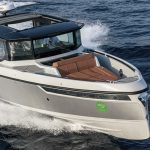Moody’s Investors Service changed to positive from stable the outlook on the ratings of Amer Sports as the company saw revenue growth of 29 percent in the year-to-date period ended September 30.
Amer Sports is majority controlled by Anta Sports but still has debt outstanding. Amer Sports brands include Salomon, Arc’teryx, Peak Performance, Atomic, Suunto, and Wilson.
Moody’s also affirmed the Amer Sports B3 corporate family rating (CFR) and its B3-PD probability of default rating (PDR). Moody’s has also affirmed the B3 ratings on the €1,700 million guaranteed senior secured term loan B (TLB) due 2026 and the €315 million guaranteed senior secured revolving credit facility (RCF) due 2025, both borrowed by Amer Sports’ subsidiary, Amer Sports Holding Oy.
“The outlook change to positive reflects Amer Sports’ sustained strong operating performance, which will lead to a faster deleveraging profile than previously anticipated, with Moody’s adjusted gross leverage ratio reducing to below 6.5x over the next 12-to-18 months,” said Pilar Anduiza, Moody’s lead analyst for Amer Sports.
Ratings Rationale
Moody’s said, “Amer Sports’ operating performance in 2021 has exceeded Moody’s expectations at the beginning of the year. Consumer demand for sports apparel, footwear and individual ball sports equipment has proven to be stronger than expected across all segments, driving revenue growth of 29 percent YTD September 2021. The Chinese market, which is predominantly direct-to-consumer (DTC), continued to outperform other segments reaching an estimated €300 million in revenues in 2021, compared with €190 million in 2019.
“In 2021, the company voluntarily prepaid €100 million of its TLB and €162 million drawings under the RCF in 2021. As a result, Amer Sports’ financial leverage, measured as Moody’s adjusted gross debt to EBITDA, improved to around 7.2x in 2021 from 10x in 2020.
“Moody’s expects the company’s sales growth to continue to be strong in 2022. Growth will come mainly from the expansion of the retail network in China, investment in the Salomon brand and the rapid development of the Arc’teryx brand. However, the rating agency notes that the company’s expansion plan entails execution risks and requires significant marketing, capital spending and working capital utilization, which will drive negative FCF generation until at least 2023. Additionally, challenges in the global supply chain and uncertainty regarding the evolution of the coronavirus pandemic remain key risks to the company’s growth prospects for next year.
“Based on Moody’s forecasts, Amer Sports’ gross leverage in 2022 will trend towards 6.5x. However, profitability in 2022 will likely remain affected by the current inflationary environment. The company’s Moody’s adjusted EBIT margin will remain modest as a result of increased commodity prices and higher logistic costs being partly offset by channel mix, price increases and cost-saving initiatives.
“Amer Sports’ B3 CFR continues to be supported by its large scale and leading market positions, underpinned by a large and diversified portfolio of globally recognized brands; its broad diversification across sports segments and geographies; the favorable long-term demand dynamics of the sporting goods market, with additional growth potential from the company’s expansion into the D2C channel of the Chinese outdoor apparel market; and the strategic guidance and potential financial support from its shareholders ANTA Sports Products Limited (ANTA Sports), FountainVest Partners Co Ltd, Mr. Chip Wilson, and Tencent Holdings Limited.
“The B3 rating is constrained by the exposure to discretionary consumer spending, which creates earnings volatility; the significant capital spending and marketing expenses required to implement its expansion strategy, which will exert pressure on margins; the relatively weak EBIT-to-interest cover ratio of around 1x; and the expectation that the company will generate negative free cash flow in the next two years to sustain the retail expansion.”
Liquidity
Moody’s said, “With a fully undrawn €315 million RCF and €318 million of cash on the balance sheet at September 2021, Amer Sports’ liquidity is adequate. Based on the rating agency’s forecasts, these liquidity sources will be sufficient to cover the company’s cash needs over the next 12-18 months, which include planned Capex of around €150-to-€190 million annually (i.e., including around €60 million related to the lease adjustment), mainly to support the ambitious retail expansion plan in China.
“Amer Sports faces significant EBITDA and working capital seasonality, with the largest cash outflows in Q2 and Q3, respectively. The sustained Capex plan, together with dividend payments to service the interest on the €3.3 billion shareholder loan and higher working capital requirements, will lead to a negative free cash flow generation in the range of €100 million to €150 million in 2022. FCF will improve from 2023 onwards to levels of around €50-to-€70 million p.a.
“The company’s RCF contains a financial covenant of senior secured net leverage not exceeding 8.0x, tested when the facility is used for more than 40 percent of its committed amount, and the company’s cash balance is below a certain level. Given the reduction in the company’s net leverage and the ample cash balance, the rating agency expects Amer Sports to maintain sufficient capacity under this covenant.”
Structural Considerations
Moody’s said, “The B3 ratings assigned to the €1,700 million guaranteed senior secured TLB due 2026 and the €315 million guaranteed senior secured RCF due 2025 are in line with the CFR, reflecting that these two instruments rank pari passu and represent substantially all of the company’s financial debt. The TLB and the RCF are secured by pledges over Amer Sports’ major brands, as well as shares, bank accounts and intragroup receivables, and are guaranteed by the group’s operating subsidiaries representing at least 80 percent of the consolidated EBITDA. The B3-PD probability of default rating assigned to Amer Sports reflects the assumption of a 50 percent family recovery rate, given the limited set of financial covenants comprising only a springing covenant on the RCF.”
Photo courtesy Salomon















